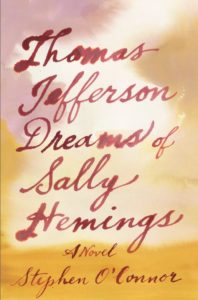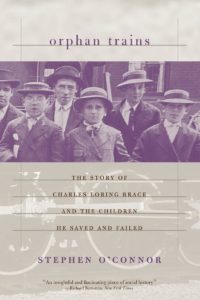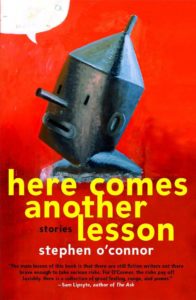MELODY NIXON interviews STEPHEN O’CONNOR

Stephen O’Connor is a writer of fiction and nonfiction, the author of four books, a professor of creative writing at Columbia University and Sarah Lawrence College, and a husband and father. His short stories “Con” and “Double Life” appear in Issues 07 and 03 respectively of The Common. His new novel, Thomas Jefferson Dreams of Sally Hemings, is forthcoming from Viking-Penguin. Melody Nixon talked with O’Connor this month while she was in Norway and he in London. They both endured the rainiest of European springs and the crackling of Skype to talk dreams, the unconscious, and the right/ability of white writers to write across identity lines.
*
Melody Nixon (MN): The title of your new novel is Thomas Jefferson Dreams of Sally Hemings. Can you tell us about the dreams in the book?
Stephen O’Connor (SO): The book contains many sorts of dreams. It opens with a brief scene in which Thomas Jefferson is dead, a state of being he prefers to life. And then, after a long, conventionally realistic scene, he has a dream in which Sally Hemings is scribbling what he sees as the notes for an invention. This dream comes back again and again all the way through the book, and by the end Sally Hemings’s invention has become the whole world—a world in which Jefferson seems to have no natural place. There are many other dreamlike scenes, in which Jefferson appears as a blimp, for example, or a sculpture, or an ape—and there are three scenes in which he and Hemings are having conversations in something like the afterlife.
MN: Why did you decide to incorporate and foreground to such an extent the dream element?
SO: The title was the result of a long conversation with my editor, during which we went through about 100 other possibilities. He and his colleagues were very concerned that the title indicated that this book was neither nonfiction—history or biography—nor a conventional historical novel. In the end we settled on this title because it made the subject matter—Jefferson and Hemings—crystal clear, yet it also suggested, via the word “dreams,” that this book would be about an indefinite reality. Dreams, of course, can be many things. They are our nightly journeys into a world of illusion, which is ruled by the subconscious. They are our hopes and ideals, and in pop songs people are always dreaming about the ones they love. All of these connotations of the word are germane to my novel, but maybe what I love most about the title is that it suggests a paradox: Jefferson as both a victim of illusion and, since he is the one “dreaming,” its creator. It presents him as someone who has and lacks power simultaneously.
MN: The style itself is somewhat dreamlike—short pieces, often as short as a single sentence or fragment—interweave with fragments as wide-ranging as fully developed historical fiction-like scenes, narrative sections heavy in dialog, through to quotes and excerpts, fact-driven, researched sections that read more “tell” than “show.” Why did you choose this mixed form?
SO: I’m hoping that by this collaging of realistic scenes with fantastic scenes, quotations, and essays, I may be able to show more about my protagonists and their world than is usually possible in conventional fiction or nonfiction. I’m the son of a psychoanalyst, so I’m very aware that we work on many levels simultaneously. We have this one level that we designate as “the real world,” in which things are more or less clear, rational, explicable, verifiable. But we also operate on levels that are much murkier and often self-contradictory. I love those dreams in which a person is simultaneously your best friend and, lets say, a jackal, because we actually can have diametrically opposed feelings about people and things, just as we can act out of motives that would seem entirely incompatible. It is common, for example, for people to help others out of genuine sympathy and because they want praise, or to feel superior to the one they are helping. So one reason I wrote my novel the way I did was that I wanted to render some of the complexity of the real world, especially when it comes to someone like Jefferson, whose character seems such a mix of the admirable and despicable that his biographer, Joseph Ellis, called him an “American Sphinx.”

MN: There is (in my eyes) a very welcome and growing shift in novel writing towards the fragmented, accruing, lyric novel—noting Jenny Offil’s fantastic Dept. of Speculation, Suzanne Scanlon’s Promising Young Women, even David Shield’s Reality Hunger as recent examples—a shift which is perhaps echoed in the recent nonfictionistas like Sarah Manguso, Eula Biss, Maggie Nelson, and going all the way back to Nathalie Sarraute’s Childhood, which you first introduced me to—all of which can perhaps illustrate a sort of post-structuralist desire to find a better fit for content than the traditional forms we have available at our disposal. How do you see your novel fitting in with this canon?
SO: I love that kind of writing, though I don’t think it is necessarily superior to traditional forms in any way. Tolstoy’s work could hardly be more conventional, and yet virtually every time I pick up one of his novels or stories, my breath is taken away by how beautifully, efficiently, and with such precise nuance he enables me to experience something wholly unexpected and true about this world. He is entirely unsurpassed by any contemporary writer in my opinion.
That said, I seem to be naturally drawn to the sort of writing you are talking about—as are, of course, an increasing number of contemporary writers. No doubt this is partly the result of the technological innovations that fling information at us at a rate that increasingly overwhelms our comprehension. And, of course, more and more of that information comes to us in entirely unrelated fragments, as we web and channel surf and dip in and out of social media. But, to be honest, what most appeals to me about this form of writing is the freedom it gives me. I love that space between one fragment of a text and another, where my mind is racing to figure out what is happening or what I should understand or feel. That is an incredibly rich moment, in which I am hyper-alert and flooded with possibilities. Writing that takes me by the hand and walks me from point to point to point seems much more limited. It only presents me with the author’s idea of what I should understand or feel, and not those zillions of ideas that pass through my mind while I am in a state of disorientation and puzzlement. Also, when the connections between fragments are left unstated, I get to play a role in the construction of the meaning—so I feel free in that way too.
MN: Do you think the form is post-structuralist, in so far as we can talk about contemporary literature with these academic descriptors, and if so, what potential does post-structuralism hold for us as writers? If not, if you were forced at gunpoint by, say, a theory-starved MFA student to categorize it in technical terms, how would you?
SO: I must confess that I am not a great fan of the terms “post-structuralist,” “post-modernist” or any of the other monikers people use to talk about contemporary art and literature. For one thing, these words are impossibly vague. When you get into a conversation using any one of them, you often find that everybody in the room means something different by it. At the same time, there are ways in which the terms can be narrow and restrictive, and mechanisms that people primarily use to inflate their sense of their own importance and to dismiss their competitors. I believe that every form of art is valid and useful and should be pursued, at least if it is honest, intelligent, and in some way or other helps us to engage more deeply with life. The only art I don’t like is that which conspires to make us believe lies.
Another reason why I am reluctant to apply any of these terms to my writing is that I don’t see anything particularly new about it—which is to say that it doesn’t seem “post” anything. We’ve been talking about the fragmentation, quotations, and dreamlike elements of the book, but the majority of it—60%, say—is conventional realism that would be right at home in any novel written since Jefferson was president. With John Ashbery, Gertrude Stein, and poets such as Apollinaire, Rimbaud, and Max Jacob, dreamlike and fragmented literary art has been practiced for a very long time. And when it comes to the novel, I don’t think there is anything I do in my book that James Joyce didn’t do in Ulysses. That book, too, is composed of disjunct fragments in different styles and voices, and it also intercuts ordinary reality with dream reality. And, of course, in Leopold Bloom, Joyce chose to write about someone of a different ethnicity than his own, an ethnicity subject to considerable prejudice in 1904 Dublin.
On the whole, I would be much more comfortable calling my book “modernist” rather than “post-modernist”—especially because I am almost entirely uninterested in the irony and the taste for pastiche that is so often cited as an ear-mark of contemporary avant-garde writing. But, even that term makes me uncomfortable—as if I am trying to dress up my work. The truth is that I’m the kind of guy who can’t stand to wear tee shirts with words or illustrations on them, and who did his best in high school not to adopt the fashions of any particular group—an impulse that did nothing to help my popularity! Maybe this tendency has its roots in the same predilection that makes me so fond of alcohol: I’m happier in the space between understandings. I feel more free there.

MN: Can you talk more about your intent to mix the two elements of consciousness and sub-? What’s your motivation for that?
SO: To go back to Ulysses, I don’t think there’s any character in all of literature who’s as well-imagined and complex as Leopold Bloom. Not only does Joyce develop the character of his protagonist through action—all the things Bloom does during a single day—and by giving us extended glimpses of his stream-of-consciousness, but also by taking Bloom to a bordello in Nighttown. In this hallucinatory, play-like sequence Joyce takes us deep into the subconscious. Bloom has visitations from his dead son and dead father. He encounters women he has seen throughout the day, some of whom seem to know about all of his sexual fantasies regarding them. A nightmare vision of his wife appears. He, himself, becomes a woman for a while. He’s ridden bareback by the madam of the Bordello, and so on. It’s all a huge surprise, shocking at times, but also touching. But the main thing is that, once we get over the shock and surprise, we see how these things are entirely consistent with the Bloom we have been following around Dublin, and so they come as a massive revelation, hugely deepening his character. In some ways, by the end of this section, I feel that I know Bloom almost as intimately and specifically as I know myself.
I didn’t think about Ulysses when I was writing my book, however. In fact it never occurred to me that there was any similarity between the two books until my editor asked who I had been influenced by and Joyce’s great book just popped into my head—though I was embarrassed to make the comparison. In a sense, though, Ulysses had been in my head for decades, along with my psychoanalyst father’s habitual way of talking about people. And so, when I conceived the idea of investigating the soul of this almost incomprehensible Founding Father, I knew instinctively that dream, hallucination, and fantasy would be part of the process.
MN: You mentioned that the dream element is a way of expressing Jefferson’s control of the situation. He is the dreamer so he is seeing, he is envisioning Hemings, she is the object of his gaze. Was it a conscious effort, to highlight the book’s themes of power and (dis)empowerment in this way?
SO: Well, not exactly conscious—at least not until I was well into my first draft of the book. The truth is that I try as much as possible never to think about what I am going to write in advance of when my fingers are actually clicking on the keyboard. I have a great respect for the unconscious as muse. I feel that my conscious mind is crammed with superficial anxieties—“Is this book any good? What will my editor think?”—and is also prone to reproduce the familiar and the clichéd. Whereas the unconscious only thinks about those things that we most desire, most fear, most need to work out if we are to survive and be happy on this planet—which makes the unconscious the natural terrain of literature. So I really, seriously try to let my unconscious guide me, and I play all sorts of tricks as I write to keep my mind off balance and to ensure that every next thing to appear on my computer screen is a surprise—at least to me.
This seemed especially important when I was writing about Jefferson and Hemings. After Abraham Lincoln, he is probably the most written-about figure in American history. There is a massive amount of fact about him out there, and many people who have very strong feelings about him—with the strongest of all, perhaps, being about his relationship with Hemings. There was a time early on when I was feeling almost crushed by the weight of fact I had to contend with and especially by the pressure of the political feelings my book could arouse, especially given my race and gender. So I decided to write the first draft entirely out of chronological order and to switch randomly from realism to unrealism to essay to prose poetry. My hope was that by never knowing what was coming next, I might have enough imaginative space for my book to come out as something more than a dutiful and politically correct docudrama.
But to speak directly about power: At some point during the composition of my first draft, I noticed that in a substantial portion of the fantasy and dream sequences, Sally Hemings had the advantage over Jefferson, and that she only gained more and more power over the course of the book. So, even though I didn’t do this consciously—at least at first—the dreamlike sequences were very much about power and specifically Hemings’s empowerment, both in terms of their content and according to the paradox suggested by the title that the dreamer is both the perpetrator and the victim of his dreams.
MN: Yes, this will be undoubtedly a controversial book. As you allude to, this will especially come into play given your position as a white author, a male author, and the timing of the book given that we’re in a period of history when it’s clear that so many civil rights are still being denied black people in this country. How has your race and gender affected your writing? How has privilege factored into your thinking about the book?
SO: Those are great and very important questions. I suppose that I have decidedly contradictory attitudes regarding the significance of my own race and gender—as I have contradictory feeling on almost everything having to do with Jefferson and Hemings. On the one hand, I think that the fact that the story of the African American experience has been mostly told by white people is a very big problem. We absolutely need a much higher number of black voices telling this story, just as we need to hear more black voices in every aspect of life.
But at the same time, I think it is dangerous and unjust to forbid anybody to speak, especially on the basis of race or gender. That’s bad policy—because once you deny any group the right to speak, even for good reasons, there is always the possibility that that policy, once established, could be turned around and used against you and those whose opinions you share. So, yes, it is 100% true that white people have held the podium for too long, but the best way to correct this problem is not to forbid white people to speak, but to bring more people of color to the podium, and to set up more podiums—and that is actually starting to happen, as a result of the successes of the Civil Rights Movement, as well as through the evolution of social media and online communication generally.
But there are other problems with forbidding people to speak because of their race or sex. For one thing, it suggests that we should only be allowed to talk about our own experience, but that strikes me as absurd. First of all, it implies that only individuals or members of a group can possibly understand their own experience. People often don’t have a clue about the nature or meaning of their lives. I know that there are many things about me that other people see far more clearly than I do myself—a very valuable lesson that I learned when I was in therapy! But the worst thing about suggesting that one can only understand the reality of one’s own race or gender is that it implies that race and sex distinctions are real, and that we are not, first and foremost, all human beings.
So yes, we need to have more people of color, more women and more members of every other discriminated against group standing at the podium (or podiums), and that is what we should all work to make happen. And when those people speak, what they say should not be judged on the basis of what group they belong to but on how valid and wise it seems.

MN: What black writers do you read, do you see bringing necessary perspectives into literary discourse?
SO: That is such a huge question, though a very interesting one. Maybe the best way to discuss it would be to talk about the books that had the most powerful effect on me as I was writing this novel—almost all of them by African Americans. Deep in the background are two masterpieces of storytelling: Ralph Ellison’s Invisible Man and, of course, Toni Morrison’s Beloved. I haven’t read Invisible Man since I was in my early 20s, but just the other day I was walking down the street thinking that it has had a huge effect on my novel, both through its fever dream realism and through the essayistic passages that are embedded throughout the book, maybe especially its opening, where the narrator explains that he is “invisible” only because people won’t see him. I don’t think it is an accident that Sally Hemings is referred to as “invisible” on more than one occasion in my book. And, in fact, Invisible was one of the zillion titles we were considering for the book. But I didn’t make the association with Ellison’s novel until just the other day.
I’ve read Beloved twice, most recently when I was first researching my novel. Morrison’s vivid, richly textured prose has had a big effect on my writing, from way back when I first read her, again in my 20s. This time, however, I was much more mercenary in my reading. I wanted to see how she handled the phenomenon of slavery, how detailed her presentation of its horrors would be, and how inflected by outrage and loathing the whole book would be. Slavery, obviously, is one of those 20-megaton topics that can totally overwhelm a narrative, and make any other more complex response than rage, horror, and despair impossible. I was interested to see that while the entire plot turned upon the barbarity of slavery, Morrison kept that barbarity at a distance, and gave it to us in a muted, lyrical fashion—which is not to say that it wasn’t also horrifying and deeply moving. Given the focus of my plot, I was also very interested in the way she would render the relationship between black and white people under slavery. White people were, of course, the perpetrators of monstrous cruelty in that book, but even so, the protagonist, Sethe, does make real, human connections with her elderly mistress and with a poor white girl she meets as she makes her way to Ohio.
I found a similar dynamic in one of the very most important books that I read during my research: Incidents in the Life of a Slave Girl, a memoir by Harriet Jacobs, first published in 1861. One of the ways in which Jacobs attempts to escape the cruelty and relentless sexual harassment of her master is by forming a sexual relationship with, as it turns out, a local politician. While it is clear from the start that Jacobs is partly using this man for protection and as a possible means of escape, a real bond does form between them nevertheless, and so she is deeply offended by his ultimate failure to really understand her or give her the help she needs.
MN: So you drew on both fiction and nonfiction. Were there other books that shaped your thinking?
SO: Yes, the other book that had a huge effect on my novel is Annette Gordon-Reed’sThe Hemingses of Monticello, a collective biography of the Hemings family and also, indirectly, of Jefferson. This immensely detailed narrative does a remarkable job not only of recreating the lives of Sally Hemings and her mother and siblings, but of delineating the complexities of her relationship with Jefferson, and of Jefferson’s own character. Gordon-Reed is unsparing in her rendition of Jefferson’s racism, hypocrisy, and shocking capacity to treat the enslaved people he had lived with for most of his life as financial assets. And yet, at the same time, it is clear that she also admires Jefferson and is inclined to believe, to some extend against her better judgment, that the bond between Hemings and Jefferson was something more than cold exploitation on both sides. Indeed, it was as I was reading Gordon-Reed’s book that I first considered the possibility that Hemings and Jefferson might have felt something like love for each other—a possibility that ended up being a powerful source of inspiration for me.
MN: Do you think about your own race and identity when reading these works? How does that translate into your intentions for this book?
SO: As the author of a novel about Jefferson and Hemings, and as a white person trying to transcend the worst of American history—in general, and as it exists within my own character—I have always been particularly interested in the way white people are portrayed in black literature, both so that I could get a better understanding of the nature and consequences of whiteness and so that I might better understand the consequences of my own actions as both a human being in this complex world and as a writer. One of the main goals as I was writing my novel was to render all the barriers of injustice, cruelty and prejudice that stood between my two protagonists, while at the same time honoring those aspects of their common humanity that drew them together.
*
Stephen O’Connor’s novel Thomas Jefferson Dreams of Sally Hemings is forthcoming from Viking-Penguin. His short story “Con” appears in Issue 07 of The Common and his short story “Double Life” appears in Issue 03 of The Common.
Melody Nixon, a New Zealand-born writer living in New York City, is the Interviews Editor for The Common.



